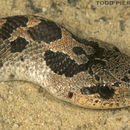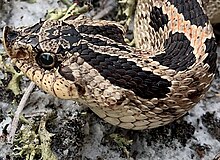pt-BR
nomes no trilho de navegação


This species has an important predatory niche in the environment. Aside from this, it rarely affects humans.
Southern Hognose Snake populations are rapidly declining throughout their range, they are believed to have been extirpated from at least two states already. Primary factors contributing to their decline include urbanization, habitat destruction, the introduction of red fire ants, increases in predation by feral cats and dogs, and pollution. Southern Hognose Snakes occupy similar habitats to Red-cockaded Woodpeckers, a federally listed endangered species. H. simus is being considered for federal listing as an endangered species.
US Federal List: threatened
CITES: no special status
IUCN Red List of Threatened Species: vulnerable
Southern Hognose Snakes eat mostly toads, primarily Scaphiopus species, and occasionally frogs and lizards.
The genus Heterodon is endemic to North America. Heterodon simus, the Southern Hognose Snake, is found in the southeastern United States, primarily from North and South Carolina, south to the coastal tip of Florida, and west as far as Mississippi.
Biogeographic Regions: nearctic (Native )
Habitats often include areas of sandy woods, fields, dry river floodplains, and hardwood hammocks. They prefer loose, sandy soils and pine forests. Southern Hognose Snakes are found in temperate zones that range from a low of 20 degrees in winter to highs over 100 degrees Fahrenheit in summer months.
Terrestrial Biomes: forest
Heterodon simus, is a short, stoutly built snake with a pointed upturned snout and wide neck. The colors range from yellow, to light brown, or grayish, and are often tinted with colors of red. Coloration is fairly constant, not highly variable as in Eastern Hognose Snakes. The scales are keeled, and usually in rows of 25. The underside of tail is not distinctively lighter in color. The anal plate is divided in halves. This is the smallest of Heterodon species, they range in total length from 330 to 559 mm, females are usually larger than males. Heterodon means 'different tooth', which refers to the enlarged teeth on the rear of the upper jaw. These teeth inject a mild venom into their prey, and serve to puncture inflated toads like a balloon to enable ingestion. They use their blunt nose to search through leaf litter and soil for prey.
Very little is known of their reproduction. Eggs are usually recorded in clutches of 6-14 eggs and are laid in late spring or early summer.
When disturbed, H. simus will hiss and flatten it's head and neck. It may also feign death, like other members of its genus (Tennant, 2003).
Southern hognose snake
These snakes reach a maximum size of about 61 cm, the average size is between 50 to 53 cm. All species of this genus can be recognized by the characteristic upturned and pointed snout. The dorsal pattern in H. simus is less variable than H. platirhinos. It consists of yellowish-brown scales contrasted by dark vertebral blotches, separated by smaller orange blotches. The ventral scales are sandy-gray (Tennant, 2003).
Like H. platirhinos, H. simus is a toad specialist (Carr, 1940; Tennant, 2003), and has developed a resistance to the toxic bufadienolides produced in the paratoid and skin glands of toads.
Southeastern USA: from eastern North Carolina southward to the coastal plain of South Carolina and Georgia to Lake Okeechobee and Tampa in Florida, and westward through the florida panhandle, Alabama (north to Calhoun County), and southeastern Mississippi (to the Pearl River separating Louisiana and Mississippi).
Mostly active during the early summer in the morning and and evening when toads are out (Tennant, 2003).
Abundant in sandhill terrain, stabilized coastal sand dunes, and disturbed terrain where sandy subterranean soil has been exposed. H. simus tend to be more fossorial than other Heterodon species (Tennant, 2003).
Holotype: not located, perhaps lost according to Edgren, 1952, Bull. Zool. Nomencl. 6:354-355.
Oviparous
Heterodon simus, commonly known as the southern hog-nosed snake, is a harmless[4] snake species endemic to the southeastern United States. No subspecies are currently recognized.[5]
Adults are 35.5–61 cm (14-24 inches) in total length. Stout with a wide neck and a sharply upturned snout, they usually have 25 rows of keeled dorsal scales at midbody.[6]
The dorsal color pattern consists of a light brown, yellowish, grayish, or reddish ground color, overlaid with a distinct row of dark blotches that alternate with smaller blotches on the flanks. The belly is distinctly darker in color than the underside of the tail in juveniles. As the snake ages, the underside usually becomes a pale white.[6]
The native habitats of Heterodon simus are xeric grasslands such as longleaf pine sandhill, upland pine forest, and scrubby flatwoods. In some areas, populations persist in mosaics of overgrown pastures, dry river floodplains, fields, and pine plantation.
The Southern hognose snake is found on the coastal plain of the southeastern United States from North Carolina, south to Lake Okeechobee in Florida, and west to Mississippi.[6]
Heterodon simus preys upon toads, frogs (especially Hyla gratiosa and Pseudacris ornata), spadefoots, and mice.[7]
This species is oviparous. mature adults mate from April through August. The thin-shelled, leathery, whitish eggs are laid in clutches of 6-14. After 55–60 days the eggs hatch. Each hatchling is 15–18 cm (6-7 inches) in total length.[8]
This species is classified as Vulnerable (VU) on the IUCN Red List of Threatened Species with the following criteria: C1+2a(i) (v3.1, 2001).[9] A species is listed as such when the best available evidence indicates that the population size is estimated to number fewer than 10,000 mature individuals, a decline of at least 10% is estimated to continue within 10 years or three generations, whichever is longer, (up to a maximum of 100 years in the future), and a continuing decline has been observed, projected, or inferred, in numbers of mature individuals and no subpopulation is estimated to contain more than 1,000 mature individuals. It is therefore considered to be facing a high risk of extinction in the wild. The population trend is down. Year assessed: 2007.[10] The Alabama Department of Conservation and Natural Resources has listed the species as possibly extirpated within the state.[11]
 Adult Southern Hognose Snake, H. Simus
Adult Southern Hognose Snake, H. Simus Heterodon simus, commonly known as the southern hog-nosed snake, is a harmless snake species endemic to the southeastern United States. No subspecies are currently recognized.
La serpiente hocico de cerdo del sur (Heterodon simus), es una especie de reptil inofensivo de la familia de los colúbridos o culebras. Es una serpiente endémica del sureste de los Estados Unidos, de la llanura costera del sudeste de Carolina del Norte, al sur de Lago Okeechobee en la Florida y el oeste hasta el sureste de Misisipi. No se reconcen subespecies.[1]
Los adultos miden 35,5 a 61 cm (14 a 24 pulgadas) de longitud. En su parte dorsal presenta un patrón en cuanto a su color; marrón claro, amarillento, grisáceo o rojizo, cubierta con una fila distinta de manchas oscuras que se alternan con las manchas más pequeñas en los flancos. El vientre es distintamente más oscura que el color en la parte inferior de la cola en los juveniles.
Su hábitat a menudo incluyen áreas de bosques de arena, campos, llanuras de inundación de los ríos secos. Prefieren suelos arenosos. Se encuentran en zonas donde la temperatura oscilan entre -29 °C (-20 °F) en invierno, a 38 °C (100 °F) en los meses de verano.[2]
Se sabe muy poco de su reproducción. Ponen de 6 a 14 huevos a finales de primavera o principios del verano. Estas culebras se alimentan principalmente de sapos, principalmente las especies del género Scaphiopus y ocasionalmente de ranas como Hyla gratiosa y Pseudacris ornata, además de lagartijas.
Las poblaciones de la serpiente hocico de cerdo del sur están disminuyendo rápidamente en toda su área de distribución, Incluso se cree que ya han sido extinguidas en al menos dos estados. Los principales factores que contribuyen a su desaparición, incluyen la urbanización, la destrucción del hábitat, la introducción de hormigas rojas de fuego, el aumento de la depredación por gatos y perros asilvestrados y la contaminación. Esta serpiente está siendo considerada para la lista federal de especies en peligro de extinción.
La serpiente hocico de cerdo del sur (Heterodon simus), es una especie de reptil inofensivo de la familia de los colúbridos o culebras. Es una serpiente endémica del sureste de los Estados Unidos, de la llanura costera del sudeste de Carolina del Norte, al sur de Lago Okeechobee en la Florida y el oeste hasta el sureste de Misisipi. No se reconcen subespecies.
Heterodon simus Heterodon generoko animalia da. Narrastien barruko Dipsadidae familian sailkatuta dago.
Heterodon simus Heterodon generoko animalia da. Narrastien barruko Dipsadidae familian sailkatuta dago.
Heterodon simus est une espèce de serpents de la famille des Dipsadidae[1].
Cette espèce est endémique des États-Unis. Elle se rencontre dans le sud du Mississippi, le Sud de l'Alabama, en Géorgie, en Floride, en Caroline du Sud et dans le sud-est de la Caroline du Nord[1].
Heterodon simus est une espèce de serpents de la famille des Dipsadidae.
Heterodon simus là một loài rắn trong họ Rắn nước. Loài này được Linnaeus mô tả khoa học đầu tiên năm 1766.[2]
Heterodon simus là một loài rắn trong họ Rắn nước. Loài này được Linnaeus mô tả khoa học đầu tiên năm 1766.

 分類 界 : 動物界 Animalia 門 : 脊索動物門 Chordata 亜門 : 脊椎動物亜門 Vertebrata 綱 : 爬虫綱 Reptilia 目 : 有鱗目 Squamata 亜目 : ヘビ亜目 Serpentes 科 : マイマイヘビ科 Dipsadidae 属 : シシバナヘビ属 Heterodon 種 : ナンブシシバナヘビ H. simus 学名 Heterodon simus (Linnaeus, 1766) シノニム
分類 界 : 動物界 Animalia 門 : 脊索動物門 Chordata 亜門 : 脊椎動物亜門 Vertebrata 綱 : 爬虫綱 Reptilia 目 : 有鱗目 Squamata 亜目 : ヘビ亜目 Serpentes 科 : マイマイヘビ科 Dipsadidae 属 : シシバナヘビ属 Heterodon 種 : ナンブシシバナヘビ H. simus 学名 Heterodon simus (Linnaeus, 1766) シノニム Coluber simus Linnaeus, 1766
和名 ナンブシシバナヘビ 英名 Southern hognose snakeナンブシシバナヘビ(Heterodon platirhinos)は、マイマイヘビ科シシバナヘビ属に分類されるヘビ。
アメリカ合衆国[1](アラバマ州、サウスカロライナ州、ジョージア州、ノースカロライナ州南東部、フロリダ州北部、ミシシッピ州南部)[2]固有種
模式標本の産地(模式産地)はチャールストン周辺(サウスカロライナ州)[2]。
最大全長61センチメートル[3]。シシバナヘビ属最小種[2]。胴体中央部の斜めに列になった背面の鱗の数(体列鱗数)は25[2](稀に27)。総排出口までの腹面にある幅の広い鱗の数(腹板数)は115-134[2]。腹面の総排出口から後部の鱗の数(尾下板数)は32-44[2]。背面には22-32個の暗色斑が入る[2]。胴体および尾腹面の色彩は淡色で、黒っぽい斑点が入る[2]。
吻端を覆う鱗(吻端板)は反りあがり、幅は左右の眼の間隔より狭い[2]。吻端板と前額板や鼻間板の間、左右の鼻間板の間、左右の前額板の間に対ではない小型鱗が3-12枚ある[2]。左右の前額板は間に小型鱗があるため接しない[2]。
食性は動物食で、カエル(スキアシガエル、ヒキガエル)を食べる[1]。
繁殖形態は卵生。1回に8-10個の卵を産む[1]。
ペットとして飼育されることもあり、日本にも輸入されている。主に飼育下繁殖個体が流通するが、流通量は少ない[3]。
|date= (help)CS1 maint: Uses authors parameter